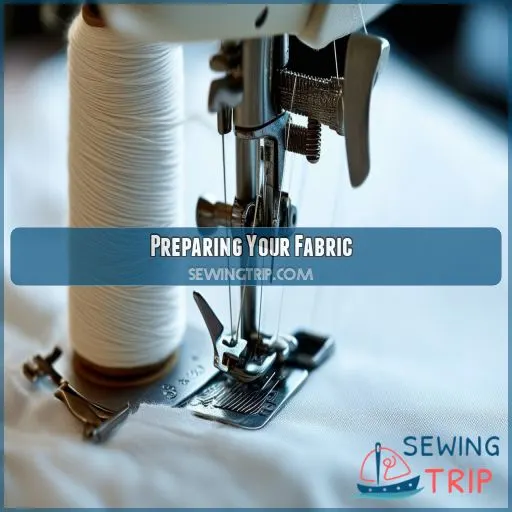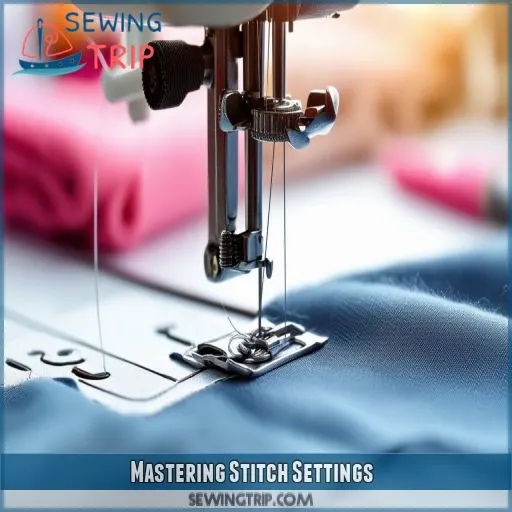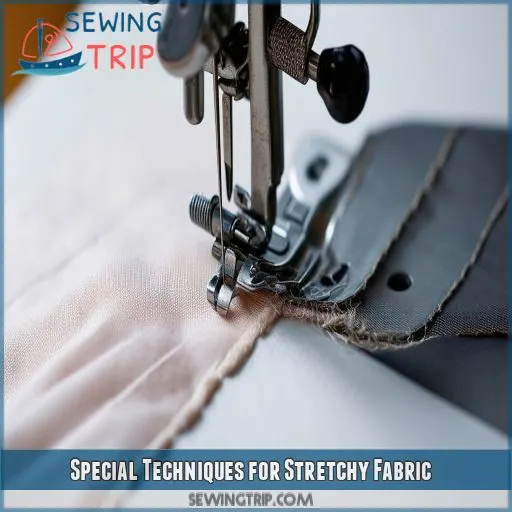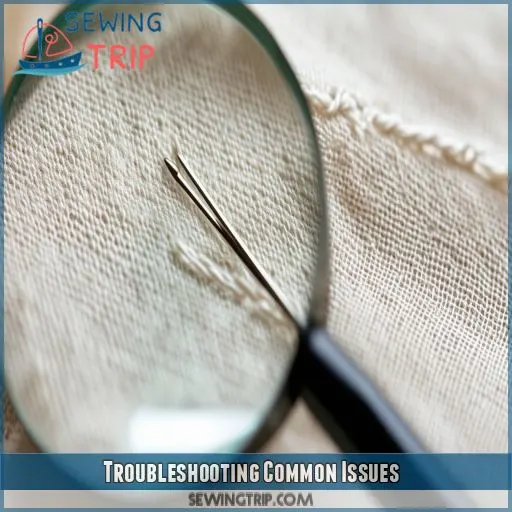This site is supported by our readers. We may earn a commission, at no cost to you, if you purchase through links.
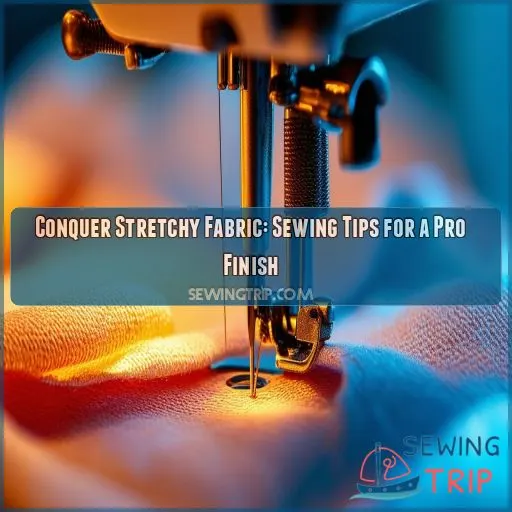
Table Of Contents
Key Takeaways
- Choose your weapons wisely: The right needles, threads, and feet are your secret sauce for stretchy success. Think of them as your trusty sidekicks in the battle against elastic enemies!
- Prep like a pro: Get to know your fabric’s quirks before you even fire up that sewing machine. It’s like giving your stretchy nemesis a thorough pat-down before the big showdown.
- Master the mighty zigzag: This stitch is the superhero of the stretchy world. It’s flexible, forgiving, and ready to save your seams from certain doom.
- Embrace the "grip and glide": Think of it as giving your fabric a gentle massage while you sew. Lead with a light touch, and your stretchy dance partner will follow your every move.
How to Sew Stretchy Fabric a Comprehensive Guide?
Ready to tackle stretchy fabric? You’ve got this!
First, arm yourself with the right tools: a stretch needle, polyester thread, and a walking foot.
Prep your fabric by understanding its stretch direction and using pattern weights instead of pins.
When it’s time to sew, opt for a narrow zigzag or stretch stitch. Keep your tension balanced and take it slow – no need to race!
Stick around, and we’ll unravel more secrets to mastering this tricky textile.
Choosing the Right Tools
Stretchy fabrics can be a headache, but choosing the right tools is half the battle won. You’ll need the right needles, threads, and sewing machine feet to tackle these tricky textiles.
Let’s get into the must-have tools for sewing stretchy fabrics like a pro.
Selecting the Best Sewing Machine Needle
When selecting a sewing machine needle, it’s important to choose the right type and size to work well with your thread and fabric.
Needle size matters. A larger needle is great for zigzag stitching and won’t damage knits, but it’s not ideal for multiple layers or high thread count fabrics.
Here are four key tips to keep in mind:
- Universal needles are great for many projects, but a sharp or ballpoint needle might be better for specific fabrics.
- Leather needles don’t work well on knits, and ballpoint needles struggle with thick woven fabrics.
- Metafil needles are perfect for pretty metallic or rayon threads, and they won’t shred or split your fancy threads.
- Stretch needles have a ‘scarf’ that gives extra room for the hook to pass close by, preventing skipped stitches on stretchy fabrics like Lycra or spandex.
Picking the Ideal Thread for Stretchy Fabric
Now, let’s talk about thread.
The right thread is key to a pro finish. Go for a thread with some stretch, like polyester or nylon. These threads have some ‘give’, so they move with your fabric. A cotton thread, on the other hand, will snap when stretched – not ideal for your stretchy project!
| Fabric Type | Recommended Thread |
|---|---|
| Knits | Polyester |
| Lycra | Nylon |
| Spandex | Polyester/Nylon Blend |
With the right thread, you’ll avoid those annoying popped seams and keep your creation looking sharp.
Using the Correct Sewing Machine Feet
Now that you’ve got your thread sorted, let’s talk feet! Your sewing machine’s feet are like your trusty sidekicks, each with a special superpower. Here are three must-have feet for stretchy fabric success:
- Walking foot: Keeps layers aligned and prevents stretching
- Zigzag foot: Perfect for those stretchy seams and hems
- Twin needle foot: Creates professional-looking parallel stitches
Don’t be afraid to experiment – finding your perfect foot is like finding the right dance partner!
Preparing Your Fabric
Before you even touch your sewing machine, prepping your stretchy fabric right is key to making projects that look amazing. You’ll learn how to work with fabric grain, cut accurately, and stabilize your material, setting the stage for a smooth sewing experience that’ll make you feel like a pro.
Understanding Fabric Grain and Stretch
Now that you’ve got your tools ready, let’s get into the fabric itself.
Understanding grain and stretch is like figuring out the personality of your stretchy material.
Think of it as the fabric’s personality – some stretch more in one direction, others are wild and stretchy all over.
Get to know your fabric’s quirks, and you’ll be on your way to sewing success!
Cutting Stretchy Fabric Accurately
Ready to tame that stretchy beast?
Let’s get into cutting accurately!
First, identify the fabric’s stretch direction – it’s your roadmap to success.
Lay it flat, smooth out wrinkles, and use pattern weights instead of pins to avoid distortion.
Sharp rotary cutters are your best friend here.
With these tricks up your sleeve, you’ll be cutting like a pro in no time!
Stabilizing Fabric With Interfacing or Stabilizer
Ever felt like your stretchy fabric has a mind of its own? Time to show it who’s boss! Interfacing or stabilizer is your secret weapon. Choose lightweight fusible interfacing for delicate fabrics, or go heavier for more structure. Fuse it to your fabric’s wrong side before cutting, and watch as your once-rebellious material becomes a dream to work with. It’s like giving your fabric a backbone!
Mastering Stitch Settings
Once you’ve got your tools and fabric ready, it’s time to master your stitch settings for stretchy fabric success. You’ll learn how to choose the right stitch type, adjust tension for smooth sewing, and harness the power of the zigzag stitch to create seams that move with your fabric.
Selecting the Perfect Stitch Type for Stretch
Now that your fabric’s prepped, it’s time to tackle the stitches. The right stitch can make or break your stretchy fabric project. Here are four go-to stitches that’ll keep your knits and spandex in check:
- Narrow zigzag: Your everyday hero
- Triple stretch stitch: The marathon runner
- Overlock stitch: The edge tamer
- Lightning stitch: The speedy secret weapon
Adjusting Tension for Smooth Stitching
Now that you’ve chosen your stitch, let’s tackle tension – the secret sauce for smooth stitching.
Think of it as a delicate dance between your needle and bobbin threads.
Too tight, and you’ll end up with a puckered mess. Too loose? Hello, loopy stitches!
Start with your machine’s default setting and adjust gradually.
Using the Zigzag Stitch for Stretchy Seams
Now that you’ve got your tension dialed in, let’s tackle the zigzag stitch – your new best friend for stretchy seams. This versatile stitch allows fabric to stretch without popping stitches. Here’s how to use it like a pro:
- Set stitch width to 2.5mm and length to 2.5mm
- Test on a scrap piece first
- Gently guide fabric without stretching
- Trim excess seam allowance for a clean finish
Special Techniques for Stretchy Fabric
You’ve got the basics down, but now it’s time to level up your stretchy fabric game with some pro techniques. These special methods will help you tame even the most unruly knits, giving you the confidence to tackle any elastic project that comes your way.
Using a Walking Foot for Smooth Feeding
Ever felt like your stretchy fabric has a mind of its own? Enter the walking foot, your new best friend in the sewing room! This nifty attachment helps feed both layers of fabric evenly, preventing those pesky tension issues. Let’s break down how this game-changer works:
| Fabric Type | Walking Foot Benefits |
|---|---|
| Jersey | Prevents wavy seams |
| Spandex | Maintains consistent seam allowance |
| Lycra | Reduces fabric slippage |
| Rib Knit | Makes sure both layers feed evenly |
| Ponte | Improves overall stitch quality |
Employing the Grip and Glide Method
Another trick up your sleeve is the grip and glide method.
Think of it as giving your fabric a gentle massage.
As you feed the material, use your fingertips to lightly grip the fabric in front and behind the needle.
This helps maintain even tension and prevents stretching.
It’s like dancing with your fabric – lead gently, and it’ll follow your rhythm perfectly.
Creating a Stable Seam With a Stretchy Fabric Guide
Now that you’ve mastered the grip and glide, let’s tackle another game-changer: the stretchy fabric guide. This nifty tool is like a personal assistant for your sewing machine, keeping your fabric in check. Simply attach it to your machine, and it’ll help maintain even tension as you sew. No more wavy seams or stretched-out nightmares! It’s like having a GPS for your stitches.
Troubleshooting Common Issues
Even the most experienced sewers can run into hiccups when working with stretchy fabric. Let’s tackle some common issues you might face and learn how to overcome them, so you can sew with confidence and achieve that professional finish you’re aiming for.
Preventing Fabric From Pulling or Twisting
Taming stretchy fabric can feel like wrangling a slippery eel, but fear not! To prevent pulling and twisting, remember these game-changing tricks:
- Cut fabric with the grain, not against it
- Use a walking foot to keep layers in sync
- Slightly stretch the fabric as you sew
- Apply tissue paper underneath for stability
Fixing Skipped Stitches and Thread Breakage
Skipped stitches and thread breakage got you in a tangle? Don’t throw in the towel just yet!
First, check your needle size – it might be too small for your fabric.
Next, tweak that tension dial; it’s your secret weapon against wonky stitches.
Still having trouble? Make sure you’re using the right thread for your stretchy fabric.
With a little patience, you’ll be stitching like a pro in no time!
Dealing With Fabric Rolling or Curling
Battling fabric that’s rolling up like a stubborn window shade? Don’t sweat it! Tame those unruly edges by adjusting your machine’s tension or using a stabilizer. For persistent curlers, try sewing along the bias or applying a stay-stitch. Remember, even pros face this fabric foe. With a bit of patience and these tricks up your sleeve, you’ll have those stretchy edges lying flat in no time!
Frequently Asked Questions (FAQs)
How do I finish edges on stretchy fabric?
You’ll want to use a stretch stitch or zigzag to finish edges on stretchy fabric. Don’t pull the fabric as you sew – let it feed naturally. For a polished look, try a twin needle or coverstitch machine.
Can I use regular patterns for stretchy fabric?
Like a chameleon adapting to its surroundings, you’ll need to adjust regular patterns for stretchy fabric. You can use them, but you’ll want to size down and modify seam allowances. It’s all about embracing the fabric’s natural flexibility.
What interfacing works best with stretchy fabrics?
You’ll want to opt for lightweight, knit interfacing that stretches with your fabric. Fusible tricot or jersey interfacing are your best bets. They’ll provide stability without compromising the fabric’s stretch, keeping your garment comfortable and form-fitting.
How to prevent wavy seams in knit fabrics?
Like taming a wild stallion, mastering wavy seams in knits requires finesse. You’ll want to use a ballpoint needle, adjust tension, and employ a walking foot. Don’t pull the fabric; let it glide smoothly under your steady hand.
Are certain thread types better for stretchy fabrics?
You’ll want to choose polyester or wooly nylon threads for stretchy fabrics. They’re like elastic bands for your seams, moving with the fabric instead of snapping. Stick with these, and you’ll be stretching your sewing skills in no time!
Conclusion
You’re now armed with a million-dollar arsenal of techniques on how to sew stretchy fabric! Remember, practice makes perfect. Don’t be discouraged if your first attempts aren’t flawless – even seasoned pros had to start somewhere. Keep experimenting with different fabrics, stitches, and tools. Soon, you’ll be whipping up perfectly fitted garments that move and stretch with ease. So go ahead, embrace those elastic materials and let your creativity flow. You’ve got this! Happy sewing, and may your stretchy projects always be a perfect fit.


